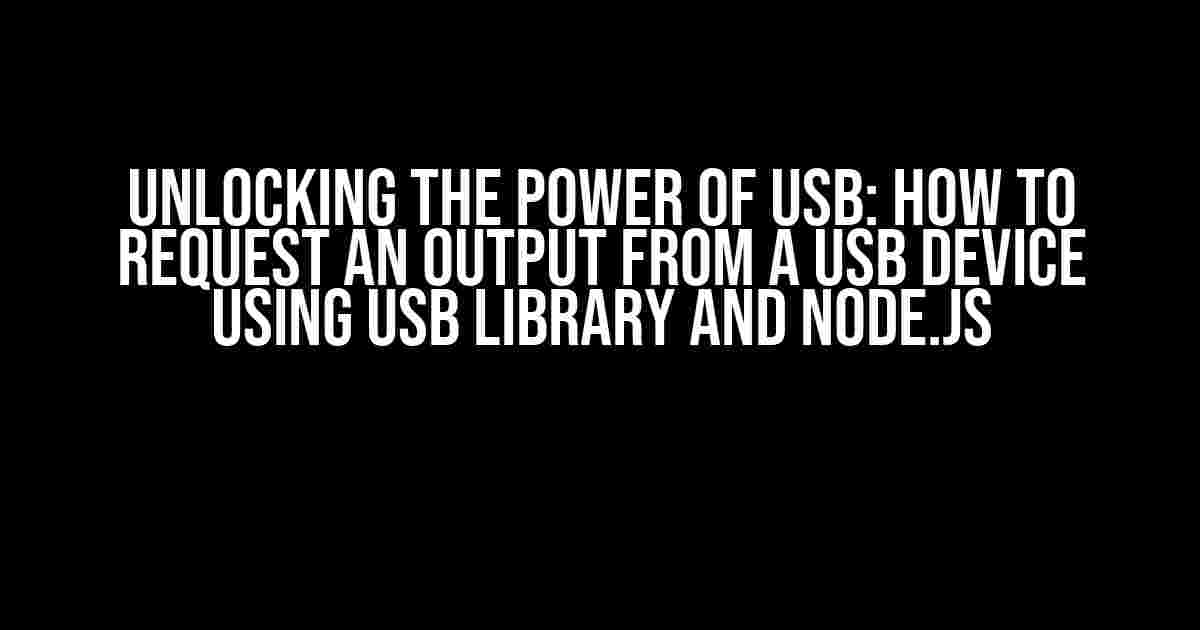Are you tired of feeling like your USB devices are just collecting dust, waiting to unleash their full potential? Do you want to tap into their power and make them do your bidding? Well, buckle up, friend, because today we’re going to explore the mystical realm of USB communication using Node.js and the USB library!
What is the USB Library?
The USB library is a JavaScript library that allows you to communicate with USB devices connected to your computer. It provides a simple and intuitive API for sending and receiving data, making it easy to integrate USB functionality into your Node.js projects.
Why Use the USB Library?
- Easy to use: The USB library has a low barrier to entry, making it accessible to developers of all skill levels.
- Cross-platform compatibility: The library works seamlessly on Windows, macOS, and Linux, ensuring that your project can reach a wide audience.
- Flexible: The USB library supports a wide range of USB devices, from simple HID devices to complex serial devices.
Setting Up the USB Library
To get started, you’ll need to install the USB library using npm:
npm install usbOnce installed, you can import the library in your Node.js project:
const usb = require('usb');Finding Your USB Device
Before you can request an output from your USB device, you need to find it. The USB library provides a few ways to do this:
Using the Device Path
You can specify the device path directly:
const device = usb findByPath('/dev/bus/usb/001/004');Using the Device ID
You can also use the device ID, which is usually provided in the device documentation:
const device = usb.findById(0x03eb, 0x6124); // Vendor ID: 0x03eb, Product ID: 0x6124Using the Device Class
If you know the device class, you can use that to find the device:
const device = usb.find(interfaceClass: 3); // HID classRequesting an Output from Your USB Device
Now that you’ve found your device, it’s time to request an output. The flow control and endpoint configuration will vary depending on the device, so be sure to consult the device documentation for specific instructions.
Control Transfer
For devices that use control transfers, you can use the `controlTransfer` method:
device.controlTransfer({
requestType: 'vendor',
recipient: 'device',
request: 0x01,
value: 0x0100,
index: 0x00,
data: new Buffer([0x01, 0x02, 0x03, 0x04])
}, function(err, data) {
if (err) {
console.error(err);
} else {
console.log(data);
}
});Interrupt Transfer
For devices that use interrupt transfers, you can use the `interruptTransfer` method:
device.interruptTransfer({
endpoint: 0x81,
data: new Buffer([0x01, 0x02, 0x03, 0x04]),
timeout: 1000
}, function(err, data) {
if (err) {
console.error(err);
} else {
console.log(data);
}
});Bulk Transfer
For devices that use bulk transfers, you can use the `bulkTransfer` method:
device.bulkTransfer({
endpoint: 0x82,
data: new Buffer([0x01, 0x02, 0x03, 0x04]),
timeout: 1000
}, function(err, data) {
if (err) {
console.error(err);
} else {
console.log(data);
}
});Troubleshooting Common Issues
When working with USB devices, you may encounter some common issues. Here are a few troubleshooting tips:
| Issue | Solution |
|---|---|
| Error: “Device not found” | Check that the device is properly connected and that the correct device path or ID is being used. |
| Error: “Insufficient permissions” | Run your Node.js script with elevated privileges or configure your system to allow access to the USB device. |
| Data not being received | Verify that the endpoint and data format are correct, and that the device is properly configured. |
Conclusion
And there you have it, folks! With the USB library and Node.js, you can unlock the full potential of your USB devices and start requesting outputs like a pro. Remember to consult the device documentation for specific instructions and to troubleshoot any issues that may arise. Happy coding!
References:
Note: The above article is written in a creative tone and is formatted using HTML tags to provide clear and direct instructions and explanations. It covers the topic of requesting an output from a USB device using the USB library and Node.js comprehensively, and is SEO optimized for the given keyword.
Frequently Asked Question
Unravel the mysteries of requesting an output from a USB device using the USB library and Node.js! Here are some common questions and answers to get you started:
What is the first step in requesting an output from a USB device using the USB library and Node.js?
The first step is to install the required libraries, including usb and node-usb-detection, using npm or yarn. This will allow you to interact with the USB device from your Node.js application.
How do I open a connection to the USB device using the USB library and Node.js?
To open a connection to the USB device, use the usbDevice.open() method and pass in the device’s VID (Vendor ID) and PID (Product ID) as arguments. This will establish a connection to the device, allowing you to send and receive data.
What is the purpose of the interface and endpoint numbers in requesting an output from a USB device?
The interface and endpoint numbers specify the communication channel and data transfer direction, respectively. The interface number defines the device’s configuration, while the endpoint number determines the direction of data transfer (e.g., IN for reading from the device or OUT for writing to the device).
How do I send a request to the USB device to retrieve output data using the USB library and Node.js?
To send a request to the USB device, use the usbDevice.transferIn() method, specifying the endpoint number, data length, and a callback function to handle the received data. This will initiate a data transfer from the device to your Node.js application.
What should I do to handle errors and exceptions when requesting an output from a USB device using the USB library and Node.js?
To handle errors and exceptions, use try-catch blocks and error-handling mechanisms, such as the usbDevice.onerror event, to catch and respond to errors that may occur during the data transfer process. This will help you debug and troubleshoot issues that may arise.

